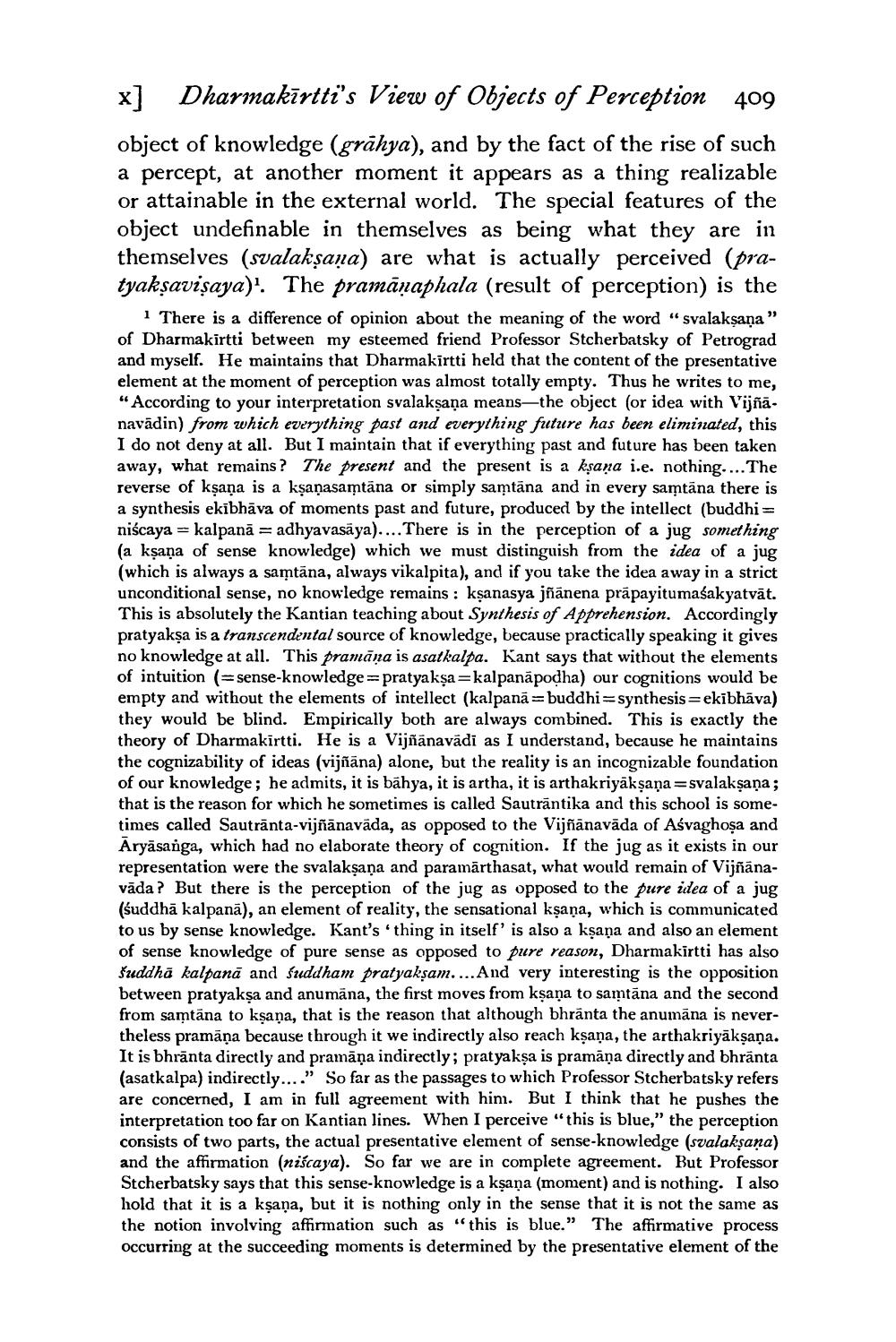________________
x] Dharmakīrtti's View of Objects of Perception 409 object of knowledge (grāhya), and by the fact of the rise of such a percept, at another moment it appears as a thing realizable or attainable in the external world. The special features of the object undefinable in themselves as being what they are in themselves (svalakṣaṇa) are what is actually perceived (pratyaksavisaya). The pramānaphala (result of perception) is the
There is a difference of opinion about the meaning of the word "svalaksana” of Dharmakirtti between my esteemed friend Professor Stcherbatsky of Petrograd and myself. He maintains that Dharmakirtti held that the content of the presentative element at the moment of perception was almost totally empty. Thus he writes to me, “According to your interpretation svalakṣaṇa means—the object (or idea with Vijñā. navādin) from which everything past and everything future has been eliminated, this I do not deny at all. But I maintain that if everything past and future has been taken away, what remains ? The present and the present is a ksana i.e. nothing. ... The reverse of ksaņa is a kşanasamtāna or simply samtāna and in every samtāna there is a synthesis ekibhāva of moments past and future, produced by the intellect (buddhi = niscaya = kalpanā = adhyavasāya).... There is in the perception of a jug something (a kşaņa of sense knowledge) which we must distinguish from the idea of a jug (which is always a samtāna, always vikalpita), and if you take the idea away in a strict unconditional sense, no knowledge remains : kşanasya jñānena prāpayitumaśakyatvāt. This is absolutely the Kantian teaching about Synthesis of Apprehension. Accordingly pratyakṣa is a transcendental source of knowledge, because practically speaking it gives no knowledge at all. This pramāna is asatkalpa. Kant says that without the elements of intuition (=sense-knowledge=pratyakşa=kalpanapodha) our cognitions would be empty and without the elements of intellect (kalpanā= buddhi=synthesis rekībhāva) they would be blind. Empirically both are always combined. This is exactly the theory of Dharmakirtti. He is a Vijñānavādi as I understand, because he maintains the cognizability of ideas (vijñāna) alone, but the reality is an incognizable foundation of our knowledge; he admits, it is bahya, it is artha, it is arthakriyaksaņa=svalaksana; that is the reason for which he sometimes is called Sautrāntika and this school is sometimes called Sautrānta-vijñānavāda, as opposed to the Vijñānavāda of Ašvaghoşa and Aryāsanga, which had no elaborate theory of cognition. If the jug as it exists in our representation were the svalakṣaṇa and paramārthasat, what would remain of Vijñānavāda ? But there is the perception of the jug as opposed to the pure idea of a jug (śuddhā kalpanā), an element of reality, the sensational kşaņa, which is communicated to us by sense knowledge. Kant's 'thing in itself' is also a kşaņa and also an element of sense knowledge of pure sense as opposed to pure reason, Dharmakirtti has also fuddhā kalpanā and fuddham pratyakşam.... And very interesting is the opposition between pratyaksa and anumāna, the first moves from kşaņa to samtāna and the second from samtāna to kşaņa, that is the reason that although bhrānta the anumāna is nevertheless pramāņa because through it we indirectly also reach kşaņa, the arthakriyākşaņa. It is bhrānta directly and pramāņa indirectly; pratyakşa is pramāņa directly and bhrānta (asatkalpa) indirectly...." So far as the passages to which Professor Stcherbatsky refers are concerned, I am in full agreement with him. But I think that he pushes the interpretation too far on Kantian lines. When I perceive “this is blue," the perception consists of two parts, the actual presentative element of sense-knowledge (svalaksana) and the affirmation (niscaya). So far we are in complete agreement. But Professor Stcherbatsky says that this sense-knowledge is a kşaņa (moment) and is nothing. I also hold that it is a kşaņa, but it is nothing only in the sense that it is not the same as the notion involving affirmation such as "this is blue." The affirmative process occurring at the succeeding moments is determined by the presentative element of the




